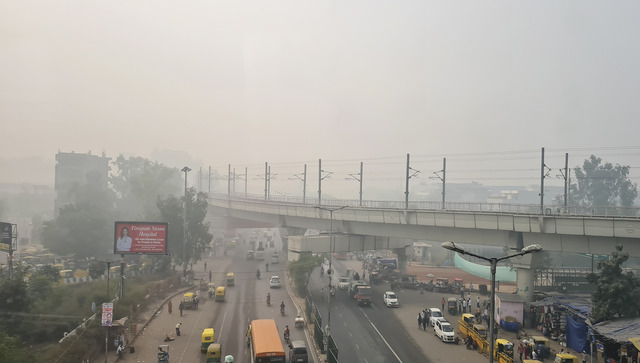Delhi witnesses the same story every year as its people are left to breathe toxic air. The National Capital is blanketed in a thick layer of smog as the Air Quality Index (AQI) touched the ‘severe’ level again on Wednesday (8 November). The Delhi government has shut schools from Thursday (8 November) till 18 November as citizens gasp for clean air. The AQI in Anand Vihar in east Delhi once again reached 999, as per AQIcn.org. The area previously reported such air quality of appalling proportions on 2 November. The air quality in many areas, including RK Puram and Punjabi Bagh, was above 400 in the ‘severe’ category.
Delhi government announces early winter break in schools from 9th to 18th November amid severe air pollution in the national capital pic.twitter.com/g9TDdHouot
— ANI (@ANI) November 8, 2023
According to Swiss group IQAir’s data at 10.30 am today, Delhi was the second most polluted city in the world. Pakistan’s Lahore topped the list, while India’s Kolkata and Mumbai were at the fourth and seventh spots, respectively. What does such toxic air mean for Delhi and its people? Why is Anand Vihar so badly affected than the rest of the National Capital? Let’s take a closer look. Anand Vihar records 999 AQI When air quality plunges to the ‘severe’ category, even healthy people become vulnerable to respiratory issues. The worsening air pollution in the city affects everyone irrespective of their age group. Dr Arvind Kumar, a senior lung specialist at Medanta Hospital, told the Independent, the current air quality in Delhi is akin to smoking about 25-30 cigarettes every day. An AQI between zero and 50 is considered ‘good’ everywhere. An increase of 50 gradually worsens the air quality. It is considered ‘severe’ when AQI is between 401 to 450, while the ‘severe +’ level is reported when the air quality index is over 450. Experts say that an AQI of 500 signals “worst air quality with worst health impacts”, according to Hindustan Times (HT). However, it must be noted that this is the highest value on the pollution measurement metric on some stations in Delhi. Others cannot report beyond 999. While System of Air Quality and Weather Forecasting And Research (SAFAR) monitoring stations cannot report AQI over 999, the Central Pollution Control Board (CPCB) can track particulate matter (PM) concentrations well beyond 999, reported The Quint. As per the website AQIcn.org’s data at 1 pm, the maximum PM 2.5 in Anand Vihar was at 558, while PM10 level was as high as 999.
#WATCH | Delhi air quality continues to remain in the 'severe' category as per the Central Pollution Control Board.
— ANI (@ANI) November 8, 2023
(Visuals from Anand Vihar, shot at 6:18 a.m.) pic.twitter.com/KxrExoTLvr
As The Statesman mentioned, air quality at 999 is almost like living in a “gas chamber”. ALSO READ:
No, Supreme Court has not banned all firecrackers: What's allowed, what's not? What high AQI means for our health Hazardous particulate matter (PM 2.5 or PM 10) concentrations in the air are a cause for worry. PM2.5 concentrations can result in asthma, heart attack, bronchitis and other respiratory issues. These tiny particles or droplets can get deep inside our lungs and further harm us. The World Health Organization (WHO) has capped the safe daily PM2.5 concentrations limit at 15 micrograms per cubic meter. However, in 2019, some parts of Delhi like Anand Vihar had recorded PM 2.5 concentrations of 2400 on the CPCB monitor, reported The Quint. At an
AQI of 999 , the concentration of poisonous Carbon Monoxide (CO) in the air could reach the fatal level of 90, reported The Statesman. According to the US’ Centers for Disease Control and Prevention (CDC), CO poisoning can lead to headache, dizziness, vomiting, chest pain and confusion. [caption id=“attachment_13364322” align=“alignnone” width=“640”] A cyclist rides amid smog in New Delhi, on 7 November. AP[/caption] Other pollutants in the air like sulphur dioxide, nitrogen dioxide, lead and ozone also increase the risk of respiratory problems, irritation in eyes and frequent headaches. What makes Anand Vihar so vulnerable? There are several factors contributing to such high levels of pollution at Anand Vihar nearly every year. Higher vehicular pollution, dust as well as emissions from nearby industries in Uttar Pradesh’s Ghaziabad exacerbate the pollution problem of Anand Vihar, which is located in close proximity to the Sahibabad industrial area and the Ghazipur landfill. Last November, Delhi environment minister Gopal Rai said the Delhi Pollution Control Committee (DPCC) identified the construction work on the Delhi-Meerut RRTS corridor, local dust and pollution from diesel buses operating from a busy bus terminus as the main reasons for higher pollution in the area. The primary pollutant in Anand Vihar was found to be PM10, HT reported last year citing the CPCB data. Anumita Roychowdhury, executive director, research and advocacy at the Centre for Science and Environment (CSE), told the newspaper at the time that consistent high AQI levels at the location means it was a local problem. “With PM10 being the lead pollutant, it shows that this is a local dust problem and the AQI comes down each time it rains as the dust settles down. In the last few years, ever since Anand Vihar was identified as a pollution hotspot, unpaved roads and dust-resuspension was a problem and that will have to be addressed." With inputs from agencies


)

)
)
)
)
)
)
)
)



